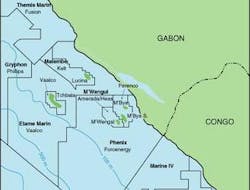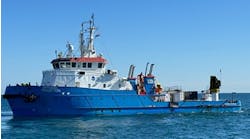By Veronica Murillo, Business Editor
A mudline-suspended, side-valve tree saves intervention costs in well development because the tree does not have to be removed for workover purposes. Kværner Oilfield Products (KOP), the developer, contends that the savings in rig time, diver intervention, and lost production, can tally up to $1 million per well.
As the name suggests, this tree is designed with the valves mounted in the horizontal run, rather than the vertical. Unlike conventional side-valve trees, this tree is completed on a 13 5/8-in. mudline system wellhead instead of an 18 3/4-in. marine wellhead.
With the side-valve tree, the tubing hanger is located in the tree body, which allows the well to be worked over without removing the tree from the wellhead. In a conventional vertical tree installation, the tree would have to be pulled before the operator could get to the tubing hanger to pull the tubing.
The mudline side-valve tree also has a drill-through capability that will pass a 12 1/4-in. drill bit, explained Ed Knerr, Subsea Engineering Manager for Vaalco Energy, which will use the mudline tree this year off Gabon. "This allows either a tieback of an existing 9 5/8-in. casing string or drilling-out and running 9 5/8-in. casing through the tree. The result is that the tree can be run with the wellhead, further reducing the overall cost of the completion."
Intervention savings
"Exact numbers on the amount of money saved depends on the type of rig used," said Bill McDougal, Manager of Business Development for KOP. "Cost savings potentially can be quite large depending upon rig rates and postponed production. We anticipate that the time required for work-over operations will be significantly reduced." Cost savings could also depend on the amount of gas and crude oil typically produced in a day for that particular well. Once diver services are brought in, the price to perform the entire workover would be even higher.
Oil in reservoirs off Gabon, where Vaalco will install the trees, contains a high paraffin fraction, meaning the wells and flowlines will need to be worked over and pigged often. "It's real attractive for producers that are on high paraffin (wax) content wells to be able to workover a well without having to remove the tree," McDougal said.
Design
Pulling a tree in a conventional workover often requires divers and diver-related work. Normally, a mudline tree is installed just to make it completely diverless, according to Kværner. However, since diver-related services aren't necessary with the new system, rig workovers become safer and less expensive.
Another development with the new mudline tree is that the initial tree installation is diverless, requiring only remotely operated vehicle intervention. Divers would only be needed to connect the flowlines.
The trees to be installed on Vaalco's wells are of a 4-in. by 2-in., 5,000-psi design, with downhole electrical penetration and hydraulic surface-controlled subsurface safety valve penetration capabilities. Currently, the side-valve equipment is under fabrication at Kværner's facilities in Houston.
Kværner has a $3 million contract with Vaalco Gabon (Etame) Inc. to build three of the mudline side-valve trees to be installed off West Africa. This will be the first application of the system. The tree combines a mudline suspension with side-valve features for shallow water use only. For the Gabon project, the tree will be installed in about 250 ft water depth.
Vaalco owns 30.35% interest in the production-sharing contract covering the Etame Block, which produces 3,700 b/d. In February 2001, log results showed approximately 20 meters of pay. Vaalco plans to run the trees offshore Gabon this summer.





